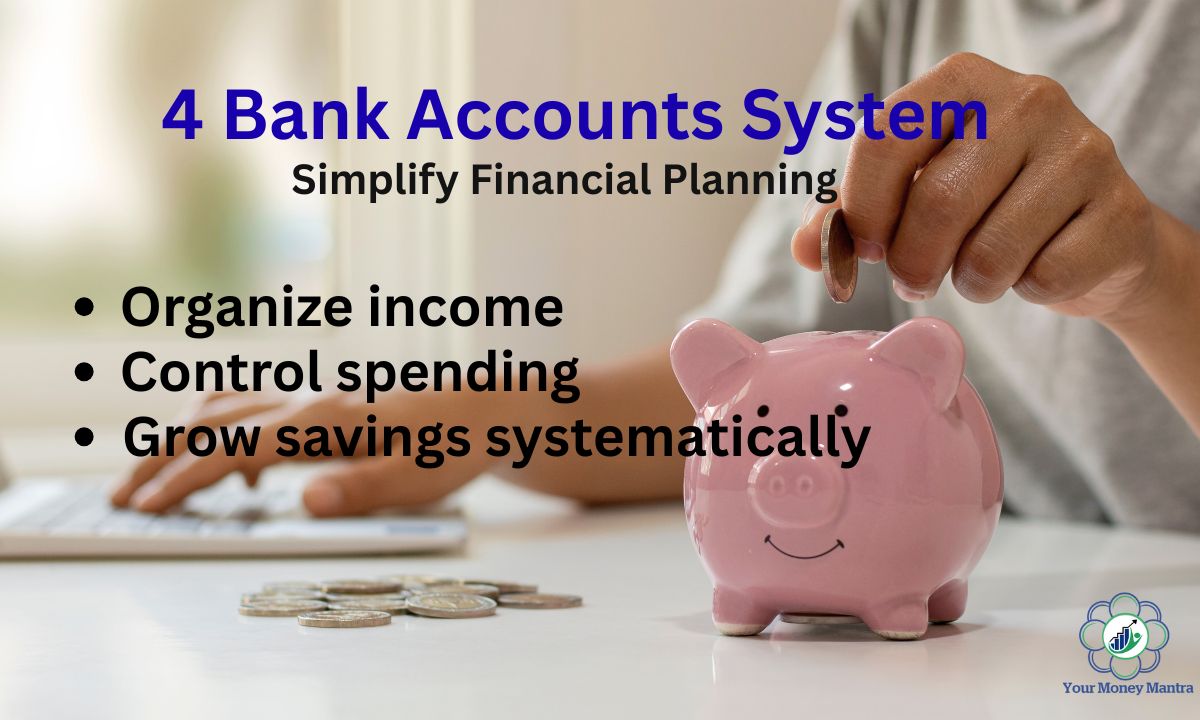Managing money is often challenging. We receive our salary, pay our bills, save a little (if anything), and by the end of the month, wonder where the money went. If this sounds familiar, the 4 Bank Account System is the answer. It is a simple yet powerful method that helps you organize income, control spending, and grow savings systematically
What is the 4 Bank Account System?
The 4 bank account system divides your total income into four specific bank accounts, each having a unique purpose:
- Essential Expenses Account
- Savings & Investment Account
- Emergency Fund Account
- Lifestyle/Discretionary Account
Instead of keeping all money in a single account and spending without control, this system gives every rupee a clear role — ensuring you meet expenses, save for future goals, and still enjoy life guilt-free.
Why Use the 4 Bank Account System?
Most people keep all their funds in a single bank account. While this seems convenient, it often leads to confusion and overspending — because there is no clarity on how much is meant for bills, savings, or lifestyle. The 4 Bank Account System solves this problem by dividing your income into four distinct buckets. Here’s why you should adopt it:
1. Clear Financial Structure
- Each account serves a single purpose — expenses, savings, emergency, or lifestyle.
- You instantly know how much you can spend without touching savings or emergency funds.
- Creates structure in your financial planning, making budgeting easier to manage.
2. Builds Financial Discipline Automatically
- Instead of manually deciding each month, the system automates your budgeting.
- By transferring funds into separate accounts on salary day, you remove the temptation to overspend.
- “Out of sight, out of mind” — savings and emergency funds stay untouched.
3. Prioritizes Wealth Creation
- Savings and investments are moved first before any spending.
- This ensures “Pay Yourself First”, a principle followed by financially successful people worldwide.
- Over time, consistent investments grow into significant wealth through compounding.
4. Prepares You for Emergencies
- Unexpected events like job loss or medical emergencies can disrupt life.
- A dedicated emergency fund account ensures you don’t dip into savings or take loans during crises.
- Gives peace of mind knowing you are financially secure.
5. Reduces Financial Stress
- No more mental calculations about what portion of money is for rent, bills, or leisure.
- Lifestyle expenses come guilt-free because you’ve already secured essentials and savings.
- Ensures smooth and transparent handling of shared financial responsibilities.
6. Flexible and Scalable
- Works for any income level — whether you earn ₹20,000 or ₹2,00,000 per month.
- Percentages can be adjusted as income grows or goals change (e.g., saving for a house, a wedding).
- Can be adapted for freelancers, salaried employees, or business owners.
7. Aligns with Indian Financial Goals
- Simplifies allocation towards popular Indian goals:
- Retirement (NPS/PPF)
- Children’s education/marriage
- Home purchase or car down payment
- Keeps lifestyle inflation in check even as income rises.
8. Prevents Common Financial Mistakes
- Stops you from accidentally using savings for shopping or vacations.
- Ensures emergency funds aren’t mixed with regular spending.
- Keeps lifestyle expenses limited — no guilt, no credit card traps.
Real-Life Impact
- Before adopting this system: Salary credited → Pay random bills → Impulse shopping → Little or no savings → Stress during emergencies.
- After adopting this system: Salary credited → Automatic allocation → Essentials paid → Investments growing → Emergency fund ready → Lifestyle spending guilt-free.
Detailed Breakdown of the Four Accounts
1. Essential Expenses Account (50-60% of income)
Purpose:
Cover all necessary living costs required to run your household.
Examples of expenses:
- Rent or Home Loan EMI
- Groceries and daily needs
- Utility bills (electricity, water, internet)
- Transportation/fuel
- Children’s school fees
Tip: Automate all bill payments from this account to avoid delays or penalties.
3. Savings & Investment Account (20-30% of income)
Purpose:
Build long-term wealth and achieve financial goals like retirement, children’s education, or buying a house.
Where to invest:
- SIPs in equity or hybrid mutual funds
- PPF/NPS for retirement
- Gold ETFs for diversification
- Recurring Deposits for short-term goals
Key Rule: “Pay yourself first” — move this money to investment as soon as salary is credited.
3. Emergency Fund Account (10-15% of income initially)
Purpose:
Stay financially secure during unforeseen events such as job loss, health crises, or vehicle breakdowns.
Target:
Build 3 to 6 months of essential expenses and park it in liquid mutual funds or savings + sweep FD account.
4. Lifestyle/Discretionary Account (10-15% of income)
Purpose:
For non-essential pleasures like travel, gadgets, movies, and dining out.
Key Rule:
Spend only from this account. Once it’s empty, wait for next month — this prevents guilt and debt.
How to Implement the 4 Bank Account System
Setting up the 4 Bank Account System may sound complicated at first, but it’s very simple when broken into steps. The key is to plan, automate, and stick to the process consistently. Follow this step-by-step guide to make it work:
Step 1: Calculate Your Net Monthly Income
- Use your net take-home salary (after tax deductions, EPF, etc.).
- For business owners or freelancers, take an average monthly income after accounting for business expenses.
Example:
If your salary is ₹1,20,000 but after tax and PF deductions, you receive ₹1,00,000, plan using ₹1,00,000.
Step 2: Decide Percentage Allocation
Set the percentage of income you’ll assign to every account. The most common split is:
- Essentials (50-60%) – Rent, groceries, bills, school fees
- Savings & Investments (20-30%) – SIPs, PPF, NPS, RD
- Emergency Fund (10%) – Liquid fund or sweep FD
- Lifestyle (10%) – Travel, dining out, shopping
Example for ₹1,00,000 Income:
- Essentials: ₹50,000 (50%)
- Savings: ₹30,000 (30%)
- Emergency Fund: ₹10,000 (10%)
- Lifestyle: ₹10,000 (10%)
(Adjust percentages if you have high EMI or want aggressive savings.)
Step 3: Open Four Separate Bank Accounts
You can do this in two ways:
Option A: Four Accounts in the Same Bank
- Easy online transfers
- One net banking login
- Ideal if your salary is credited here
Option B: Mix of Traditional and Digital Banks
- Essentials in your salary account (HDFC, SBI, ICICI, etc.)
- Investments in another bank (Axis, Kotak) to reduce the temptation to spend
- Emergency fund in a high-interest savings account or sweep FD
- Lifestyle in a zero-balance digital account (Fi, Jupiter, Paytm) for UPI payments.
Step 4: Automate Transfers on Salary Day
- Set standing instructions or auto-debit to move money as soon as salary arrives.
- This ensures “Pay Yourself First” — savings are done before spending starts.
Example:
Salary credited on the 1st of every month:
- On 2nd, ₹30,000 auto-transfer to Savings Account (for SIPs)
- ₹10,000 to Emergency Fund
- ₹10,000 to Lifestyle Account
Step 5: Link Expenses to the Right Account
- Essentials Account → Link debit card/UPI for bills, rent, EMI, groceries
- Savings Account → Link to mutual fund app, PPF, or NPS for auto-SIP
- Emergency Fund Account → Keep separate, use only in emergencies
- Lifestyle Account → Use UPI with your Lifestyle Account for discretionary spends such as food, shopping, or vacations.
(This prevents accidental spending from wrong accounts.)
Step 6: Monitor and Adjust Monthly
- Review spending and savings every 3 months.
- Increase savings percentage when income grows.
- Refill the emergency fund if used during an emergency.
- Reduce lifestyle spending if essentials exceed 60%.
Step 7: Combine with Goal Planning
- Use the Savings Account to create separate sub-goals:
- Retirement SIP
- Child’s education fund
- Vacation fund
- Down payment fund
Pro Tips for Success
- Start small: Even if you can’t open 4 accounts immediately, begin with 2 (Essentials + Savings) and add others later.
- Use automation tools: Standing instructions, UPI autopay, or salary sweep features make the process effortless.
- Track via mobile apps: Use expense tracking apps (Walnut, Moneyfy, INDmoney) to monitor balances in each account.
- Review annually: Adjust percentages when major life events occur (marriage, child, home loan).
Example: Allocation for ₹1,00,000 Monthly Income
| Account Type | Percentage | Amount (₹) |
| Essential Expenses | 50% | 50,000 |
| Savings & Investment | 30% | 30,000 |
| Emergency Fund | 10% | 10,000 |
| Lifestyle/Discretionary | 10% | 10,000 |
Example: Allocation for ₹50,000 Monthly Income
| Account Type | Percentage | Amount (₹) |
| Essential Expenses | 60% | 30,000 |
| Savings & Investment | 20% | 10,000 |
| Emergency Fund | 10% | 5,000 |
| Lifestyle/Discretionary | 10% | 5,000 |
Benefits of the 4 Bank Account System
The 4 Bank Account System isn’t just about splitting money — it’s about bringing structure and discipline to personal finance. Here are the major benefits
1. Clear Separation of Money
- No more confusion about what portion is for bills, savings, or fun.
- Each rupee has a defined purpose: Essentials, Investments, Emergencies, or Lifestyle.
Example: Rent and EMIs are paid from Essentials, vacations from Lifestyle, and SIPs from Savings.
2. Automatic Financial Discipline
- By splitting funds on salary day, you avoid overspending on lifestyle or impulse buys.
- Emergency and savings funds stay untouched unless truly required.
- This prevents the “one big account” trap where lifestyle expenses eat into savings.
3. Builds Wealth Consistently
- Savings and investments happen first — not “whatever is left over”.
- Over time, consistent SIPs and deposits compound into significant wealth.
- Supports long-term goals such as building a retirement fund, funding your child’s education, or buying a home.
4. Prepares You for Financial Emergencies
- A dedicated emergency fund avoids stress during job loss, medical emergencies, or car breakdowns.
- Prevents the need for credit card debt or personal loans during times of crisis.
- Gives peace of mind knowing 3–6 months’ expenses are covered.
5. Reduces Money-Related Stress
- Essentials are always funded — no fear of missing rent or bills.
- Lifestyle expenses are guilt-free — you know you’ve already saved and invested.
- Couples can manage joint finances more peacefully with clear boundaries.
6. Flexible and Scalable
- Works for all income levels — ₹20,000 or ₹2,00,000 per month.
- Percentages can be adjusted based on personal goals (e.g., higher savings for aggressive wealth building).
- Simple to expand as your income grows — just raise the transfer amounts in the same ratio.
7. Helps Control Lifestyle Inflation
- As income grows, the lifestyle account grows moderately, not at the cost of savings.
- Prevents the common mistake of spending more simply because you earn more.
- Ensures long-term financial independence rather than short-term luxuries.
8. Encourages Goal-Oriented Planning
- The Savings Account can be split into sub-goals: retirement, kids’ education, vacation, etc.
- Set a clear goal for the Emergency Fund — typically 3 to 6 months’ living costs.
- Lifestyle fund ensures planned indulgence rather than random spending.
9. Improves Financial Awareness
- Monthly tracking of 4 accounts builds a habit of budgeting.
- You see how much you spend on essentials vs lifestyle.
- Encourages mindful decisions — e.g., “Should I increase my savings from 30% to 40%?”
10. Suitable for Indian Financial Products
- Easy to integrate with SIPs, PPF, NPS, EPF, and liquid mutual funds.
- A lifestyle account can be linked to UPI (PhonePe, Paytm) for small spends.
- An emergency account can use sweep FD or liquid funds for quick access and better returns.
The 4 Bank Account System turns chaotic money management into a simple, automated plan. It ensures security (essentials + emergency), growth (savings), and enjoyment (lifestyle) — all without stress or guilt. Over time, this habit leads to financial freedom and peace of mind
Common Mistakes to Avoid in the 4 Bank Account System
While the 4 Bank Account System is simple, many people misuse it or fail to follow it consistently. Avoiding these common mistakes ensures the system works effectively and improves your financial health.
1. Using the Emergency Fund for Non-Emergencies
- Mistake: Dipping into the emergency account for vacations, gadgets, or lifestyle purchases.
- Why it’s harmful: Leaves you unprotected during real crises like job loss or medical emergencies.
- Solution: Define what qualifies as an “emergency” — e.g., hospitalization, loss of income — and commit not to touch this fund otherwise.
2. Not Automating Transfers
- Mistake: Relying on manual transfers each month.
- Why it’s harmful: You may forget, delay, or skip transfers, resulting in inconsistent savings.
- Solution: Set standing instructions or auto-debits from your salary account on payday.
3. Overestimating Lifestyle Budget
- Mistake: Allocating too much for lifestyle spending (dining out, shopping, vacations).
- Why it’s harmful: Reduces savings and delays wealth-building goals.
Solution: Cap lifestyle spending at 10–15% of income and adjust only if essentials and savings are secure.
4. Ignoring Periodic Review
- Mistake: Sticking to the same percentages even when income or expenses change.
- Why it’s harmful: Financial plans must adapt — e.g., after a salary hike, wedding, or new home loan.
Solution: Review allocation every 6 months or after major life changes
5. Keeping All Accounts in One Bank Without Labeling
- Mistake: Having 4 accounts in the same bank but forgetting which is for what.
- Why it’s harmful: Leads to accidental spending from the wrong account.
Solution: Use nicknames or labels (Essentials, Savings, Emergency, Lifestyle) in net banking or UPI apps.
6. Delaying the Setup
- Mistake: Waiting for a “perfect time” or higher income before starting.
- Why it’s harmful: Delays habit formation and compounding benefits.
- Solution: Start small, and today, even two accounts (Essentials + Savings) can be a good beginning.
7. Mixing Credit Card Payments
- Mistake: Paying credit card bills from multiple accounts randomly.
- Why it’s harmful: It confuses budgeting and may lead to overspending.
- Solution: Pay credit card bills only from the Essentials Account and always in full.
8. Ignoring Inflation and Goal Changes
- Mistake: Keeping fixed savings contributions for years without revising for rising expenses or new goals.
- Why it’s harmful: Underfunds future goals (retirement, child’s education).
- Solution: Increase savings contribution when income rises and revisit goals annually.
9. Not Building an Emergency Fund Fully
- Mistake: Contributing small amounts but never completing the 3–6 month target.
- Why it’s harmful: Partial emergency funds won’t cover big crises.
- Solution: Prioritize filling the emergency fund first, then divert extra to investments.
10. Forgetting to Link Investments
- Mistake: Parking savings in the Savings Account without actually investing.
- Why it’s harmful: Misses out on returns and allows money to get spent accidentally.
- Solution: Automate SIPs, PPF, or RD directly from the Savings Account on a fixed date.
Indian Context Tips for the 4 Bank Account System
The 4 Bank Account System works beautifully in India because we have multiple savings options, digital banking tools, and diverse investment products. Here’s how to adapt it for Indian conditions:
1.Choose Banks Smartly
- Essentials Account:
Use your salary account with a large bank (HDFC, SBI, ICICI, Axis) — easy bill payments and EMI auto-debits. - Savings & Investment Account:
Open a separate bank account (Kotak, IDFC First, Federal Bank) with good online access for SIPs, RDs, or goal-based transfers.
- Emergency Fund Account:
Use banks with sweep FD or high-interest savings accounts (IDFC First, AU Bank, IndusInd). - Lifestyle Account:
Digital zero-balance accounts like Fi Money, Jupiter, Paytm Payments Bank are ideal — link them to UPI for spending control.
2. Use Sweep FD or Liquid Funds for Emergency Fund
- Sweep FD: Automatically converts idle savings into FD, earning 6–7% interest.
- Liquid Mutual Funds: Offer better returns (5–7%) and instant redemption (within 30 minutes).
- Best for: Parking 3–6 months’ expenses safely while keeping it accessible.
3. Automate SIPs and Investments
- Use auto-debit mandates (NACH) or standing instructions for mutual fund SIPs and recurring deposits.
- Start with index funds, hybrid funds, or PPF for long-term wealth building.
Example: HDFC Index Fund, Parag Parikh Flexi Cap Fund, PPF in Post Office/Bank.
4. Integrate UPI and Mobile Banking
- Link Essentials and Lifestyle accounts to UPI apps (Google Pay, PhonePe, Paytm) for fast payments.
Keep Savings and Emergency accounts separate and do not link them to UPI to avoid accidental spending.
5. Manage Credit Card Wisely
- Pay credit card bills only from Essentials Account.
- Do not use credit cards for lifestyle overspending — maintain 100% payment before due date.
- Use reward points for essentials like groceries or fuel.
6. Plan for Indian Goals
- Common financial goals for Indian families:
- Child’s Education/Marriage
- Home Purchase
- Retirement Corpus
- Car Upgrade
- Vacations
Allocate Savings Account to these goals via multiple SIPs or recurring deposits.
7. Handle Irregular Income (Freelancers/Business Owners)
- Compute the average income for the previous 6–12 months to set a baseline..
- Transfer fixed percentages to each account based on this average.
- In surplus months, boost savings and emergency fund rather than lifestyle spending.
8. Tax-Saving Integration
- Use ELSS mutual funds, PPF, and NPS from Savings Account for 80C and 80CCD(1B) benefits.
- Track 80D (Health Insurance) premiums from the Essentials Account.
- Emergency Fund does not give tax benefits but ensures liquidity.
9. Use Digital Goal-Tracking Tools
- YourMoneyMantra apps can track investments and goals.
- Use Walnut, Moneyview for expense tracking across multiple accounts.
This ensures clarity across all four accounts without manual effort.
10. Adjust for Lifestyle Inflation
- Each time salary increases, increase savings percentage first, not lifestyle account.
- Example: From 30% savings to 35%, lifestyle stays 10%.
- Avoid falling into the trap of “earn more → spend more.”.
Final Thoughts
Managing money doesn’t have to be complicated. The 4 Bank Account System gives you a simple framework that separates your income into four clear buckets — Essentials, Savings, Emergency, and Lifestyle. By doing this, you automatically ensure:
- Bills and living costs are always covered
- Savings and investments grow consistently
- An emergency fund protects you during tough times
- Lifestyle spending is guilt-free and under control
This system works for any income level and can be started immediately — even with two accounts initially, expanding to four as you grow. Combined with automation and periodic reviews, it becomes a lifelong money habit that leads to financial security and freedom.
Remember: Financial planning is not about how much you earn, but how smartly you manage what you have. The 4 Bank Account System can be your first step toward a stress-free and goal-oriented financial life







